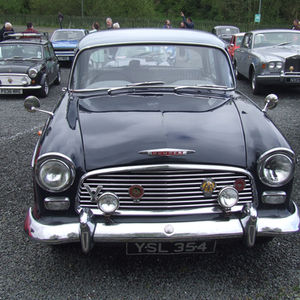
The Humber Motor Company was a pioneering British automobile manufacturer, originally founded in 1868 by Thomas Humber as a bicycle company. By 1896, Humber had entered the automotive industry, producing some of the earliest British cars.
Throughout the early 20th century, Humber became known for its high-quality, reliable vehicles, including luxury saloons and military staff cars**. In 1931, the company became part of the Rootes Group, which helped expand its market presence.
Humber’s most famous models included the **Humber Hawk, Super Snipe, and Imperial**, which were favored by government officials, diplomats, and executives. However, after Chrysler acquired Rootes in 1967, the Humber name gradually disappeared, with its last model, the Humber Sceptre Mk III, being discontinued in 1976.

Humber Hawk (1957-67)
The **Humber Hawk (1957-1967)** was a British **luxury saloon** produced by **Humber**, part of the **Rootes Group**. It featured **unitary construction**, making it more modern than its predecessors. Powered by a **2,267cc four-cylinder engine**, it delivered **73bhp** and could reach speeds of **83mph** Review | Honest John](https://classics.honestjohn.co.uk/reviews/humber/hawksuper-snipe/).
The **Series IV**, introduced in **1964**, had a sleeker design with more glass, reflecting styling changes seen in the **Hillman Super Minx** Review | Honest John](https://classics.honestjohn.co.uk/reviews/humber/hawksuper-snipe/). The Hawk shared its body with the **Humber Super Snipe**, which had a more powerful **six-cylinder engine** and a more luxurious interior Review | Honest John](https://classics.honestjohn.co.uk/reviews/humber/hawksuper-snipe/).
*****

Humber Imperial (1964-67)
The **Humber Imperial (1964-1967)** was the **flagship luxury model** of the Humber range, built by the **Rootes Group**. It was based on the **Humber Super Snipe Series V**, but featured **higher-end refinements**, including **power-assisted steering, automatic transmission, and a vinyl roof**.
The Imperial was designed for **executives and diplomats**, offering **West of England cloth or leather upholstery**, picnic tables, and even **adjustable reading lamps** for rear passengers. It was a true **statement of prestige**, embodying British luxury motoring of the era.
*****

Humber Sceptre Mk 1 (1963-65)
The **Humber Sceptre Mk 1 (1963-1965)** was a **luxury sports saloon** produced by **Humber**, part of the **Rootes Group**. It was based on the **Hillman Super Minx**, but featured a **sleeker roofline, wraparound windscreen, and quad-headlamps**, giving it a more refined and sporty appearance - Motor Car History](https://motor-car.net/humber/item/12125-sceptre-1963-76).
Powered by a **1,592cc four-cylinder engine**, it produced **80bhp**, offering **spirited performance** for its class - Motor Car History](https://motor-car.net/humber/item/12125-sceptre-1963-76). The Sceptre was positioned at the **top of the mid-range Rootes lineup**, above the **Hillman Super Minx and Singer Vogue**, and was originally intended as a **four-door replacement for the Sunbeam Rapier**.
It came with **high-end features**, including **disc front brakes, overdrive, screen washers, reversing lamp, and a full range of instruments** - Motor Car History](https://motor-car.net/humber/item/12125-sceptre-1963-76). A **Mk IA version** was introduced in **1964**, with minor updates. Production of the **Mk I and IA models** totaled **17,011 units**.
*****

Humber Sceptre Mk 2 (1965-67)
The **Humber Sceptre Mk 2 (1965-1967)** was a **refined luxury saloon** produced by **Humber**, part of the **Rootes Group**. It featured **updated styling**, including a revised front end with **quad-headlamps** and a more prominent grille.
Under the hood, it was powered by a **1,725cc four-cylinder engine** with **twin carburettors**, delivering **85bhp** and a **top speed of around 95mph** - Motor Car History](https://motor-car.net/humber/item/27035-humber-sceptre-mk-ii). The Mk 2 was known for its **smooth ride**, thanks to its **four-speed manual transmission with optional overdrive** - Motor Car History](https://motor-car.net/humber/item/27035-humber-sceptre-mk-ii).
Inside, the Sceptre Mk 2 boasted **high-end features**, including **wood veneer dashboard, full instrumentation, and comfortable upholstery**, making it a **prestigious choice** for executives and professionals - Motor Car History](https://motor-car.net/humber/item/27035-humber-sceptre-mk-ii).
*****

Humber Super Snipe (1938-67)
The **Humber Super Snipe (1938-1967)** was a **luxury saloon** produced by **Humber**, part of the **Rootes Group**. It was introduced in **1938**, combining the **four-litre inline six-cylinder engine** from the **Humber Pullman** with the **chassis and body** of the **Humber Snipe**, resulting in a car with **enhanced performance** and a **top speed of 79 mph**.
During **World War II**, the Super Snipe was used as a **British military staff car**, and its chassis was adapted for the **Humber Light Reconnaissance Car**. Post-war, the model evolved through several **Mark versions**, each becoming **larger, more powerful, and more modern**.
In **1958**, the Super Snipe was redesigned with a **unitized chassis and body**, featuring a **2.6-litre six-cylinder overhead-valve engine**. The final **Series VA version** was produced until **July 1967**, marking the end of the **big Humber era**.
*****
View Gallery
There may be no better way to communicate what we do than through images. As you browse our site, take a few moments to let your eyes linger here, and see if you can get a feel for our signature touch.














